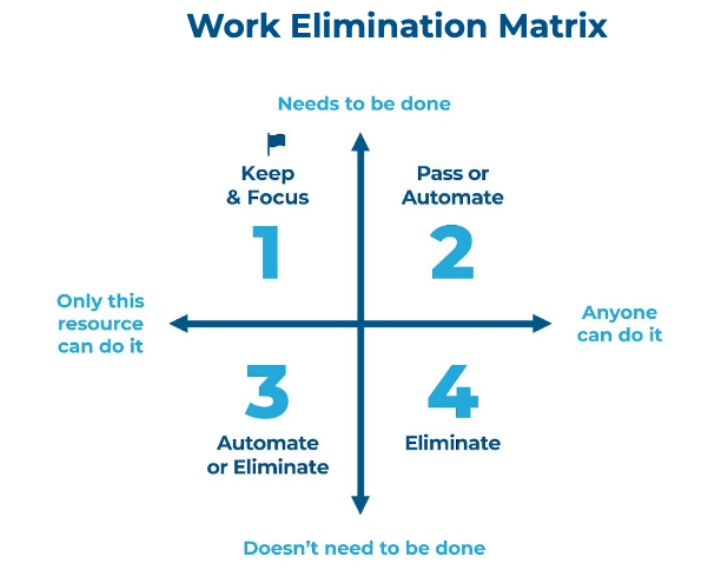How Much Does an Employee Cost? How to Double Productivity with a Smaller Headcount
And how to turn your team into profit centers to profitably scale a consulting agency with less reliance on you, the CEO.
Employing workers can be costly. The expenses for each hire are beyond a salary. From benefits, insurance, and taxes to equipment, office space, and training, the actual cost of each employee can stack up.
To profitably scale a consulting agency, hiring the right people is critical. And there are ways to turn staffing expenses to turn your employees into profitable assets.
With the right approach, you can keep your payroll manageable while attracting and retaining top talent. You can turn your team from cost centers into profit centers.
Employees are valuable assets that can drive growth and profitability. A strong team will allow you to let go of the business’s day-to-day.
The high cost of employees means you’ve got to be very choosy and staff strategically.
One exceptional top performer will generate the output of 5 mediocre people.
It’s the 80/20 rule at work.
In the first part of this article, we’ll talk about the real and hidden costs of hiring. Then, in part 2, I’ll share with you better ways to hire, including __ software and AI tools that will supercharge your team to do even better work while staying nimble. We’ll share with you our best resources for getting 30-100% more staffing output for the same budget. This means you can grow A LOT faster with your existing resources.
Part 1: How much does a key employee cost?
Beyond salary: the actual cost of an employee.
Besides the salary, keep in mind the following expenses:
- Payroll taxes: These include Social Security, Medicare, and unemployment taxes.
- Benefits: Health insurance, retirement plans, and paid time off will increase costs.
- Overhead costs: Office space, technology, equipment, and supplies are necessary components.
- Training and development: Investing in your employees’ skills is essential for growing, but it will add to the cost of your workforce.
- Turnover costs: Employees who leave create expenses related to lost productivity, recruitment, and training replacements.
For example, let’s say you hire an employee with a base salary of $50,000.
- Payroll taxes: Depending on your state, this can be around 15% of the base salary, which would be $7,500.
- Benefits: A benefits package could cost around 30% of the base salary, adding another $15,000.
- Overhead costs: Assigning an office space and other necessary equipment might cost around $2,000 annually.
- Training and development: You might spend around $1,000 per year per employee.
- Turnover costs: If the employee leaves after two years, you might spend another $5,000 on recruiting and training a replacement.
For some roles in your company, you’ll have to hire this traditional way. But there are often other ways to get the job done that will open you up to greater access to skills and person-hours for your budget.
Alternative staffing strategies for faster growth.
These strategies are more flexible, get you better skills, and often is more cost-effective:
- Niche Productized Services: Common tasks like bookkeeping, website management, business development, video editing, graphic design, etc… or
- Design Pickle
- Automation Agency
- Bean Ninja’s
- Fractional Resources: Accounting and CFO services can be outsourced to get better skills and processes and often reduce overhead. Services that aren’t good to use fractional are operations, as you really need that skill inside your company. You can hire a full-time person for the same investment as a fractional resource using the resources below.
- A great company for service agencies is Momentum Accounting, which will set up your whole financial operating systems and accounting functions.
- Hire permanent talent from other markets: Access a global pool of skills by hiring remote workers who can work from anywhere.
and
- Executive Assistants: There are services that offer trained EAs for a reasonable monthly fee. They cover their paid vacation and health insurance, and you have a great full-time resource who becomes your right hand and can save key resources 10-20 hours per week at minimum.
- Jobrack: Hire exceptional talent from Eastern Europe who are skilled, well-trained, and eager for the opportunity. Our clients started staffing with Jobrack in 2020 because we couldn’t get enough Operations Manager and leader applicants. Now, they are our top place to hire and the top hiring job board in Eastern EU. You can get the same talent for 50% of US salary. Their internet is solid, English is very good, and cultural difference is only slight. (I can’t believe I just shared our secret weapon with you. Find your talent, and we’ll help you train and develop them to run your business for you.)
- Automate repetitive tasks: Implementing technology to automate repetitive jobs can help reduce labor costs and improve efficiency.
- Use AI tools like Tango to document processes like magic and Fathom to record and summarize meetings, which is so much faster to grab a transcript to work off, too. Otter.ai is to automate note-taking and have a bot where you can ask questions like the biggest objections, challenges, etc. Then, you can ask it to write follow-up messages to save you a ton of time. Lavendar.ai will train you or your EA to write better emails that get responses from prospects.
- Properly optimized and automated project management systems like ClickUp can make remote work clean, enjoyable, and profitable. Which your team will love, and is a lot lower overhead. ZenPilot is an amazing resource to build in best practices proven to save agency teams dozens of hours per week. They’ll build a custom blueprint for how your project management system should be constructed based on best practices. Then, you’ll have a new project management system up and running in a few weeks. (After doing this the wrong way a few times, I wish we would have found ZenPilot sooner.)
- Eliminate unnecessary work: Use the “Work Elimination Matrix” to uncover work that can be eliminated or automated.
These strategies can help you save money while ensuring you have the right mix of skills on your team.
Part 2: Turning employees from cost centers into profit centers
Source: Chapter 14 of The Hands-Off CEO book by Mandi Ellefson.
Perry enjoyed 367% growth over three years as he replaced himself from much of the business. He had dramatically decreased his stress level. Yet, year after year, Perry would overbook his schedule with legacy client engagements.
A quick calculation showed that with their opportunity for growth, they were missing out on at least 3-5M of revenue over the next few years by doing so. Not to mention, new clients came in paying more and didn’t expect to work with the CEO.
To reach the next level where Perry would stop leaving millions of dollars on the table, he needed to let go at the next level. That’s where we often get. We delegate a lot. It brings us to the next level. But to continue growing, we need to build leaders who can grow the company.
When we empower leaders, they become the increasing profit centers in the business.
But many CEOs teeter between two extremes when working with their team.
- Micromanage – If you go the micromanaging route, you may as well do the thing yourself. You’re acting as the puppet master. They never develop the confidence to own it. This approach creates learned helplessness and dependence on you.
- Abdicate – “You go do it and figure it out.” This is setting up the person to sink or swim without the support they need to be successful. They cannot meet your standards, and you’ll have to jump in to fix it or constantly give feedback.
Both approaches set up good people to fail. They don’t allow the person to develop the confidence to own the role because they haven’t been empowered to do so.
Over time, you’ll lose your best, most capable people and be left with a team of puppets because they haven’t been set up to win. This is not a path to CEO freedom.
Setting leaders up to win.
Moving from the extremes of abdication or micromanagement to an outcome-based approach is a crucial shift CEOs take to scale without becoming a slave to the business. It means defining success and managing those agreements rather than managing the person. It takes intention, but it allows you to be fair and empowering.
By approaching your employees as assets, you can maximize their productivity and impact on your business. There are some strategies to turn your employees into profit centers.
- Have dashboards that track meaningful metrics weekly. Top performers want to know exactly how to impact the business’s success and what’s expected of them.
- Invest in your leaders! Invest your time. Set aside a budget to develop them and help them grow. They will love you for it, and their skills will help the business grow.
- Communicate what success looks like and let them own it. Let them figure out the best way. Top performers want autonomy and want to be creative problem-solvers. Build a culture of owners and support them to win.
- Foster career development and offer mentorship and apprenticeship programs to maximize retention and job satisfaction.
- Empower the whole team to drive growth. Set clear strategic goals that you manage weekly. The whole team needs to know what the 3-year goals, 12-month goals, and what their specific quarterly objectives are. This is not just an exercise for the CEO to do and push it down to the team. Get buy-in so they are excited to take ownership and be promise-keepers you can count on. (You need to model that too.)
- Recognize and reward high performance to keep everyone focused and motivated.
Expect A LOT more. But BE a lot more, too.
If you want great people, you need to be a great leader. There are no shortcuts there.
Create a compelling vision that first inspires you. Establish and live core values that teach the hold team how to show up and approach work.
Do everyone a favor and fire those who aren’t pulling their weight. Or who aren’t a cultural fit. They will destroy your culture, and you’ll lose the trust of your best people if you let them stay.
When you make this shift, you’ll accelerate growth while working less and delivering better client outcomes.
Want our help building up your leaders to run and grow your business? We first help CEOs find the time and cash to invest in growth. Then, make the model sustainable by increasing profits with an Irresistible Offer.
After that, we support the team in operationalizing it and removing the CEO from the day-to-day. We only accept clients we can help unlock millions of dollars of profitable growth. Are you next?
Book a Scalable Growth Session to see what’s standing in the way of you having these types of results and what might be possible for your situation.Not sure yet… go check out our case studies of successful service agencies who’ve moved mountains following our proven systems to increase profits and scale.







